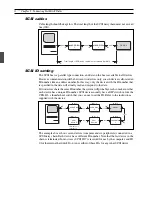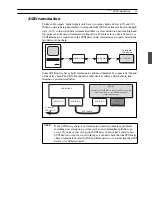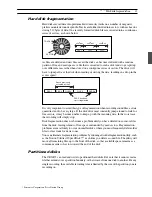
SCSI termination13
SCSI termination13
SCSI termination
13
SCSI termination
Unlike audio signals, digital signals only have two values: high and low (+5V and 0V).
When no data is being transmitted, it is important that SCSI bus lines are kept in the high
state (+5V), so that when data is transmitted there is a clear distinction between high and
low pulses and the data is transferred without error. To achieve this, a device known as a
SCSI terminator is connected in the SCSI daisy chain. A terminator is usually fitted to the
last device in the chain.
Some SCSI devices have a built-in terminator, and must therefore be connected at the end
of the daisy chain. The CBX-D3 and many other devices utilize a detachable in-line
terminator, as illustrated below.
NOTE:
If the SCSI daisy chain is not terminated correctly, numerous problems
including data corruption, system crashes, and intermittent glitches can
occur. If you have just set up your SCSI daisy chain or have added a new
SCSI device to it and it is not working as it should, check that the SCSI daisy
chain is terminated correctly. If the problem persists, try connecting the SCSI
devices in a different order.
Terminate
this device
HARD DISK
1
CBX-D3
HARD DISK
2
SCSI
SCSI
SCSI
To the next
SCSI device
CBX-D3
(In this case the CBX-D3 is the last device connected
in the daisy chain, so the SCSI terminator is
connected as shown)
SCSI PLUG
SCSI
TERMINATOR
HARD DISK 2
SCSI PLUG
SCSI PLUG
SCSI CABLE

























